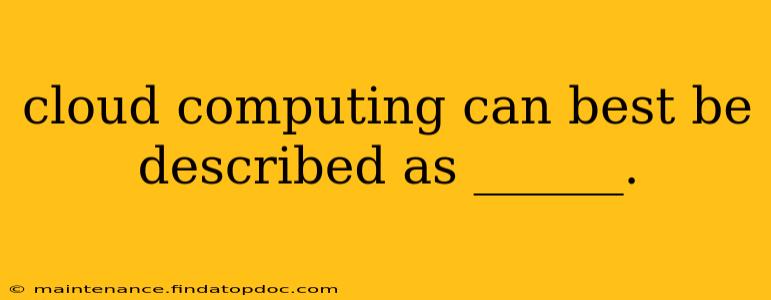Cloud Computing: A Comprehensive Guide to the On-Demand Digital Ecosystem
Cloud computing can best be described as on-demand access to shared computing resources—including servers, storage, databases, networking, software, analytics, and intelligence—over the Internet ("the cloud"). Instead of owning and maintaining physical data centers and IT infrastructure, businesses and individuals leverage these resources from providers like Amazon Web Services (AWS), Microsoft Azure, and Google Cloud Platform (GCP), paying only for what they use. This model offers unparalleled scalability, flexibility, and cost-effectiveness, transforming how we work, live, and interact with technology.
This seemingly simple definition encompasses a vast and rapidly evolving landscape. Let's delve deeper into the nuances and address some common questions surrounding this transformative technology.
What are the different types of cloud services?
Cloud services are typically categorized into three main models:
-
Infrastructure as a Service (IaaS): This provides the most fundamental building blocks—virtual machines (VMs), storage, and networking. Think of it as renting the raw materials to build your own applications and systems. Examples include Amazon EC2, Microsoft Azure Virtual Machines, and Google Compute Engine.
-
Platform as a Service (PaaS): PaaS offers a more complete environment, including operating systems, programming languages, databases, and web servers. This allows developers to focus on building and deploying applications without managing the underlying infrastructure. Examples include AWS Elastic Beanstalk, Microsoft Azure App Service, and Google App Engine.
-
Software as a Service (SaaS): This is the most user-friendly model, providing ready-to-use software applications accessed over the internet. Think of email services like Gmail or productivity suites like Microsoft 365. You don't manage anything; you simply use the software.
Beyond these core models, other cloud service models exist, including:
-
Function as a Service (FaaS): Executes individual functions or pieces of code on demand, ideal for event-driven architectures. Examples include AWS Lambda, Azure Functions, and Google Cloud Functions.
-
Serverless Computing: A broader term encompassing FaaS and other approaches that abstract away server management entirely.
What are the benefits of cloud computing?
The benefits of cloud computing are numerous and significant:
-
Cost Savings: Eliminates the need for large upfront investments in hardware and infrastructure, paying only for what you consume.
-
Scalability and Flexibility: Easily scale resources up or down based on demand, adapting to changing business needs.
-
Increased Efficiency: Automate tasks and streamline workflows, freeing up IT teams to focus on strategic initiatives.
-
Enhanced Collaboration: Facilitate teamwork and collaboration through shared access to data and resources.
-
Improved Disaster Recovery: Cloud providers offer robust disaster recovery and business continuity solutions.
-
Accessibility: Access data and applications from anywhere with an internet connection.
What are the disadvantages of cloud computing?
While cloud computing offers many advantages, it's essential to acknowledge potential drawbacks:
-
Vendor Lock-in: Migrating from one cloud provider to another can be complex and costly.
-
Security Concerns: Data security and privacy are paramount considerations; careful selection of a reputable provider is crucial.
-
Internet Dependency: Cloud services require a reliable internet connection. Outages can disrupt operations.
-
Limited Control: You relinquish some control over your infrastructure and data compared to on-premise solutions.
How secure is cloud computing?
Cloud security is a top priority for providers. Reputable providers invest heavily in security measures, including data encryption, access controls, and regular security audits. However, security is a shared responsibility; users must also implement appropriate security practices to protect their data and applications.
What are some examples of cloud computing in everyday life?
Cloud computing is woven into the fabric of our daily lives. Examples include:
-
Streaming Services: Netflix, Spotify, and other streaming platforms rely on cloud computing to deliver content on demand.
-
Email Services: Gmail, Outlook.com, and Yahoo Mail are all SaaS applications hosted in the cloud.
-
Social Media: Platforms like Facebook, Twitter, and Instagram use cloud computing to manage massive amounts of data and user interactions.
-
Mobile Apps: Many mobile apps store data and process information using cloud-based services.
In conclusion, cloud computing represents a fundamental shift in how we access and utilize computing resources. Its flexibility, scalability, and cost-effectiveness are driving its adoption across industries and transforming the way businesses and individuals operate in the digital world. Understanding its different models and potential benefits and drawbacks is crucial for anyone navigating the modern technological landscape.
